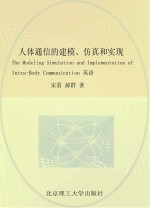

人体通信的建模、仿真与实现PDF电子书下载
- 电子书积分:8 积分如何计算积分?
- 作 者:宋勇,郝群著
- 出 版 社:北京:北京理工大学出版社
- 出版年份:2016
- ISBN:9787568217255
- 页数:118 页
1.Introduction 1
1.1 Concept of Intra-Body Communication 1
1.2 Safety Issue 2
1.3 Advantages of IBC 2
1.4 Applications of IBC 3
1.4.1 Biomedical monitoring 3
1.4.2 Consumer electronics 5
1.4.3 Secure space 6
1.4.4 Application prospect 6
1.5 The Scope of This Book 7
1.5.1 The modeling and the simulation of IBC 7
1.5.2 The implementing methods of IBC 7
1.5.3 Book contents 8
References 9
2.Theory Foundation 11
2.1 IBC Types 11
2.1.1 Electrostatic coupling type 11
2.1.2 Galvanic coupling IBC 12
2.2 Theoretical Analysis of Signal Transmission Within the Human Body 14
2.2.1 Signal represented as electromagnetic wave 14
2.2.2 Signal represented as current density 18
2.3 Theoretical Explanation of Galvanic Coupling IBC 20
2.4 Theoretical Explanation of Electrostatic Coupling IBC 22
2.4.1 Electric fields of electrostatic coupling IBC 22
2.4.2 Model of electrostatic coupling IBC 23
2.5 Conclusions 23
References 24
3.IBC Modeling Based on the Transfer Function Method 27
3.1 Current Researches 27
3.1.1 Galvanic coupling IBC 27
3.1.2 Electrostatic coupling IBC 29
3.2 IBC Modeling Based on the Transfer Function 31
3.2.1 Modeling of galvanic coupling IBC 31
3.2.2 Modeling of electrostatic coupling IBC 36
3.3 IBC Simulation Based on the Transfer Function 39
3.3.1 Method 39
3.3.2 Signal transmissions along arm 39
3.3.3 Signal transmissions along different paths 41
3.4 Discussions 45
References 45
4.IBC Modeling and Simulation Based on FEM 47
4.1 Finite-element Modeling Method 47
4.2 The Research Status 48
4.2.1 Research of ETH 48
4.2.2 Research of HKUST 49
4.3 Modeling of the Whole Human Body 49
4.3.1 The modeling of the head and the neck 51
4.3.2 The modeling of the torso 51
4.3.3 The modeling of the arm and the 52
4.3.4 The connection of the human body part models 52
4.4 IBC Simulation Based on FEM 52
4.4.1 Galvanic coupling IBC 52
4.4.2 Electrostatic coupling IBC 54
4.4.3 Electromagnetic parameters 57
4.5 Simulation Results and Analysis 58
4.5.1 Simulation results of galvanic coupling IBC 58
4.5.2 The measurement experiments 62
4.5.3 Simulation results of electrostatic coupling IBC 66
4.6 Conclusions 77
References 77
5.IBC Based on Electro-Optical Modulation 79
5.1 Current Studies 80
5.2 IBC Based on a Mach-Zehnder EO Modulator 81
5.2.1 Circuit model 82
5.2.2 Mathematical model 84
5.2.3 The complete mathematical model 88
5.3 Experiments 89
5.3.1 Sensitivity 89
5.3.2 Frequency response 91
5.3.3 Temperature characteristic 95
5.4 Conclusions 97
References 98
6.Signal Transmission System of IBC 99
6.1 Current Research 99
6.2 IBC System 100
6.2.1 System structure 100
6.2.2 DBPSK modulation and demodulation 101
6.3 Transmitter and Receiver Design 102
6.3.1 Transmitter circuit 102
6.3.2 Receiver circuit 103
6.3.3 Electrodes design 107
6.4 Experiments and Discussion 107
6.4.1 Experiment device 107
6.4.2 Influence of carrier frequency 108
6.4.3 Influence of baseband frequency 109
6.4.4 Influence of signal transmission path 110
6.5 Conclusions 112
References 112
7.Conclusions and Future Outlook 114
7.1 Summary of Intra-Body Communication 114
7.2 Future Research 115
7.3 Future Applications of IBC 116
References 117
- 《计算机网络与通信基础》谢雨飞,田启川编著 2019
- 《BBC人体如何工作》(英)爱丽丝.罗伯茨 2019
- 《区块链DAPP开发入门、代码实现、场景应用》李万胜著 2019
- 《数学物理方法与仿真 第3版》杨华军 2020
- 《通信电子电路原理及仿真设计》叶建芳 2019
- 《柏里曼人体结构绘画教学描摹本 第2册 头手足结构》杨建飞主编 2019
- 《智能制造高技能人才培养规划丛书 ABB工业机器人虚拟仿真教程》(中国)工控帮教研组 2019
- 《人体寄生虫学学习指导与习题集 供基础 临床 预防 口腔医学类专业用 第2版》诸欣平,苏川 2018
- 《微机原理与单片微机系统及应用 基于Proteus仿真》编者 2019
- 《人体机能学 第2版》张建龙著 2018
- 《交响舞乐》贾达群著 2019
- 《贾达群 即兴曲 梨园弦诗 为独奏二胡、京剧三大件与大型民族管弦乐团 总谱 2019》贾达群著 2019
- 《贾达群 狂想曲 梨园腔魂 为独奏唢呐与大型民族管弦乐团 总谱 2019》贾达群著 2019
- 《两乐章交响曲》贾达群著 2019
- 《贾达群 序曲 梨园鼓韵 为中国独奏打击乐、川剧锣鼓与大型民族管弦乐团 总谱 2018》贾达群著 2019
- 《老北京土语趣谈》白鹤群著 2013
- 《高端装备工业设计创新研究与实践》肖旺群著 2018
- 《天籁地声 广西情歌之旅》宋安群著 2017
- 《美国教育法与判例》秦梦群著=American public school law and court cases 2004
- 《诺贝尔奖获奖者传记丛书 爱因斯坦传》李梦群著 2012
- 《大学计算机实验指导及习题解答》曹成志,宋长龙 2019
- 《指向核心素养 北京十一学校名师教学设计 英语 七年级 上 配人教版》周志英总主编 2019
- 《大学生心理健康与人生发展》王琳责任编辑;(中国)肖宇 2019
- 《大学英语四级考试全真试题 标准模拟 四级》汪开虎主编 2012
- 《大学英语教学的跨文化交际视角研究与创新发展》许丽云,刘枫,尚利明著 2020
- 《北京生态环境保护》《北京环境保护丛书》编委会编著 2018
- 《复旦大学新闻学院教授学术丛书 新闻实务随想录》刘海贵 2019
- 《大学英语综合教程 1》王佃春,骆敏主编 2015
- 《大学物理简明教程 下 第2版》施卫主编 2020
- 《指向核心素养 北京十一学校名师教学设计 英语 九年级 上 配人教版》周志英总主编 2019
